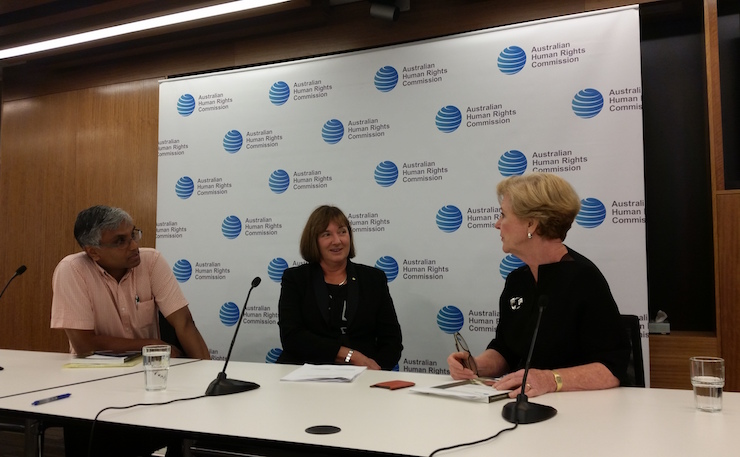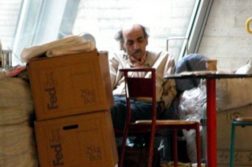A standard global test for child development has delivered an incredible result. The children Australia holds in immigration detention are the most at risk ever given the assessment. Max Chalmers reports.
Tucked into the middle of the most recent report into the damage done by Australia’s immigration detention network is an astounding detail. When examined with a standard paediatric test that helps determine the likelihood of developmental problems, the children held in the Wickham Point detention centre returned worse results than any ever formally recorded before.
Anywhere on earth.
The report was handed down by the Australian Human Rights Commission President Gillian Triggs on Thursday along with paediatricians and child health experts Professor Elizabeth Elliott and Dr Hasantha Gunasekera, who had conducted a series of tests and interviews during visits to the Wickham Point ‘Alternative Place of Detention’.
The centre is 35kms from Darwin and at the time of the inspection held 76 children, many of whom have spent time on Nauru.
Among the grim testimony, anecdotes, and data the doctors collected, the results of one test in particular stand out.
It’s known as PEDS, ‘Parental Evaluations of Developmental Status’, and it’s used to assess children under the age of eight. It works like this: parents are asked to respond to a questionnaire about their children, which doctors can then process and use to place the child in a category of risk.
According to Dr Sue Woolfenden, a paediatrician and academic who co-authored a review looking at known PEDS studies, when properly applied the test allows you to gauge how “developmentally vulnerable” a child is.
To put it at its most basic, the more kids you have who fall into one of the test’s top categories of risk, the more worried you should be.
And that’s why Dr Hasantha Gunasekera is so worried.
Even as testing was still being conducted at Wickham Point the paediatrician realised he was seeing something out of the ordinary.
“We took it back, we scored it, then we found we were getting these massively high rates,” he told New Matilda.
The findings were so severe, the scores so bad, Dr Gunasekera wondered whether worse had ever been recorded. He called Dr Woolfenden to ask.
Among the children detained by Australia at Wickham Point, 100 per cent were found to fall into the highest two categories of developmental risk, “higher than any published PEDS results anywhere in the world,” according to the Human Rights Commission’s final report.
There are some caveats to that finding (explained below), but Dr Woolfenden confirmed to New Matilda that, on the basis of her research, the results taken from Wickham Point detention centre are worse than any formally recorded.
“This demonstrates there is a very concerning level of risk among these children that is higher than has been recorded previously,” she said.
It should be noted, PEDS is not a score of actual harm. It doesn’t tell you that children have been harmed, or are experiencing developmental issues. It’s used to predict which children are most likely to have other development issues, and flags them for further diagnostics.
Dr Woolfenden’s research looked at 37 other PEDS studies, which took in 210,242 subjects. It found that, on average, around 30 per cent of children assessed had been put into the top two categories of risk.
Recall, again, that the number at Wickham Point was 100 per cent. Every single child fell into the high or moderate risk category. None of the recorded studies examined by Dr Woolfenden anywhere on earth returned a result of more than 81 per cent.

The reason for these results, according to Dr Gunasekera, is obvious. The children in Wickham Point face return to Nauru, indefinite detention, or being sent back to the countries they fled. They’ve experienced a double trauma: the journey from danger and the despair of detention.
The Human Rights Commission’s report does note a couple of positives about Wickham Point. The threat of physical violence is low and there are no complaints with the bathrooms, it observes. But the harm being inflicted in the centre is nonetheless pervasive.
“Physically they are safe,” one father of three told Commission staff when he was asked about his children. “But mentally they are not. All of the time they ask why are we here so long? Are we going to stay forever? What’s going to happen to us?”
The PEDS results align with other assessments done at Wickham Point during the Human Rights Commission’s visit. Speaking to the media at the report launch, Professor Elliott, who visited the centre with Dr Gunasekera, noted that of the 20 children screened for Post-Traumatic Stress Disorder, 19 came back in the significant risk category.
Given a questionnaire of their own to complete, every single child quizzed reported bad dreams about returning to Nauru. One boy told interviewers he experienced nightmares in which he was returned to Nauru where his body and face would be covered by cockroaches.
He was nine-years-old.
Dr Gunasekera told New Matilda PEDS has proved an accurate and useful tool, and is a standard test used across New South Wales. It is especially helpful when assessing younger children who cannot be directly tested for trauma; it “gives you a glimpse of child trauma”, in his words.
The test can be criticised on the basis it involves interviews with adults instead of directly assessing children, but Dr Gunasekera was emphatic that the assessment cannot be gamed by parents, and that the responses from Wickham Point were indicative of authentic results.
“I can tell you as a paediatrician I’ve been trained to administer this tool. I cannot work out how scoring is going to be until I get back and do the scoring. There’s no way the parents are going to be gaming the system and trying to answer in a certain way to get a certain outcome,” he said.
Dr Woolfenden is cautious in her assessment of the findings in the Commission’s report – she wants to know more about how the testing was carried about before commenting further (the stress of detention on parents, for example, could impact results). But overall she agrees the result is, at the very least, “a concerning snapshot”.
The Commission’s report, meanwhile, calls for all children to be removed from immigration detention.
“Under no circumstances should any child detained on the mainland be returned to or transferred to Nauru,” it recommends.
That decision now rests with the Turnbull government as it mulls the implications of its High Court victory.
There are 267 children in Australia facing a return to Nauru. If Professor Elliott, Dr Gunasekera, and the Australian Human Rights Commission are to be believed, the government’s choice will have nothing short of lifelong implications for them.
Donate To New Matilda
New Matilda is a small, independent media outlet. We survive through reader contributions, and never losing a lawsuit. If you got something from this article, giving something back helps us to continue speaking truth to power. Every little bit counts.





